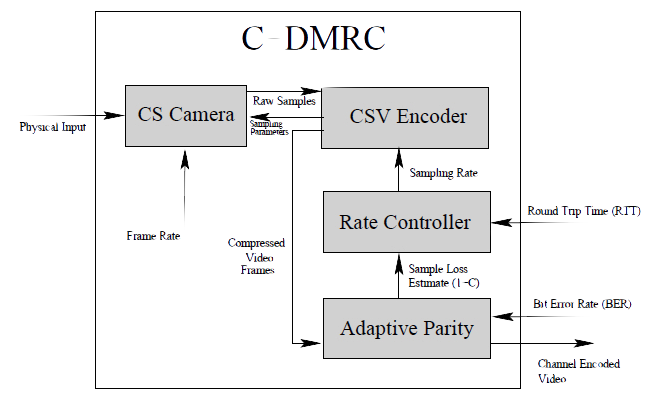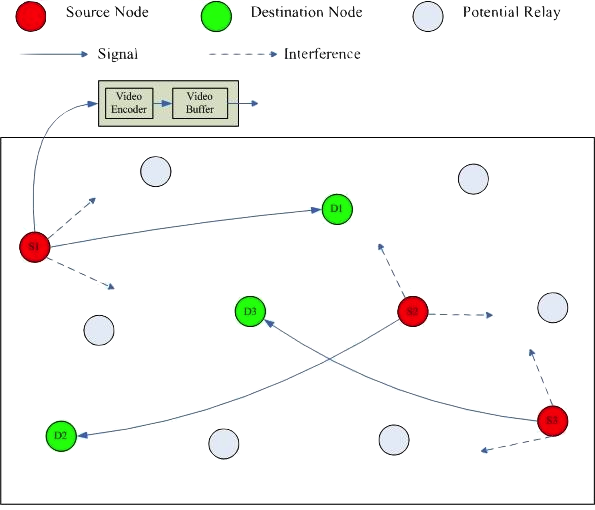Wireless Multimedia Sensor Networks
|
Compressive Distortion Minimizing Rate Control (C-DMRC) In recent years, there has been intense research and considerable progress in solving numerous wireless sensor networking challenges. However, the key problem of enabling real-time quality-aware video streaming in large-scale multihop wireless networks of embedded devices is still open and largely unexplored. There are two key shortcomings in systems based on sending predictively encoded video through a layered wireless communication protocol stack, the encoder complexity and the low resiliency to channel errors. |
 |
Compressed sensing is a new paradigm that allows the faithful recovery of signals from far fewer measurements than traditional methods based on Nyquist sampling. Hence, CS can offer an alternative to traditional video encoders by enabling imaging systems that sense and compress data simultaneously and much faster, at very low computational complexity for the encoder. We developed the Compressive Distortion-Minimizing Rate Control (C-DMRC) system to take advantage of the distortion minimizing rate control (DMRC), adaptive parity and the CSV video encoded. |
|
Audio Sensor Networks for Energy Efficiency in Buildings Monitoring of device level energy consumption in residential spaces is a challenging task. There are two approaches to achieve device level energy monitoring. One of them is to attach a power meter to each device in the household. Although this approach is able to provide fine-grained reports, it is not preferred due to its installation and maintenance cost. Other approach is based on measuring the total energy consumption of the household and using sophisticated statistical signature detection algorithms to estimate the device level energy consumptions. This approach suffers from the multi-state appliances that change their state over time. Thus, it can only provide coarse-grained energy consumption reports. |

|
We propose a new approach that is able to provide fine-grained device level energy consumption reports without the installation and maintenance complexity of existing solutions. We employ an audio sensor network to ease the installation process and reduce the cost of overall system. A multi-tier decision mechanism is designed to detect running devices. Sensor nodes try to identify the running devices based on audio data and only the result of identification is reported to the sink. If a sensor node fails to identify running devices, audio data is reported to the sink where a sophisticated identification is performed based on time and energy consumption. |
 |
In this project, we study the cross layer design for video streaming over cooperative wireless multimedia sensor networks. The objective is to maximize the sum peak signal-to-noise ratio (PSNR) of multiple video sessions, by jointly regulating the video encoding rate at application layer, deciding the optimal relay selection strategy and controlling the transmission power for each source and relay node at lower layers. The research concentrates on at least three aspects: 1) Derive the upper bound for sum PSNR and study the interactions among video rate control, power allocation and relay selection. 2) Design distributive algorithms, which are implementable and has performance close to the optimum. 3) Implement and verify the algorithm using hardware, e.g., USRP2. Extension of the research includes incorporating the mobility of nodes and routing, employing the game theory to study the fairness among multiple nodes. |
Related Publications
-
S. Colonnese, F. Cuomo, L. Chiaraviglio, V. Salvatore, T. Melodia, I. Rubin "CLEVER: a Cooperative and Cross-Layer Approach to Video Streaming in HetNets," IEEE Transactions on Mobile Computing, Nov. 2017. [pdf] [bibtex]
-
S. Colonnese, F. Cuomo, T. Melodia, I. Rubin, "A Cross-Layer Bandwidth Allocation Scheme for HTTP-based Video Streaming in LTE Cellular Networks," IEEE Communications Letters, vol. 21 no. 2, pp. 386-389, Feb 2017. [pdf] [bibtex]
-
N. Cen, Z. Guan, T. Melodia, "Inter-view Motion Compensated Joint Decoding of Compressive- Sampled Multi-view Video Streaming," IEEE Transactions on Multimedia, vol. 19, no. 6, pp. 1117-1126, June 2017. [pdf] [bibtex]
-
S. Colonnese, F. Cuomo, T. Melodia, L. Ferranti, R. Guida, M. Pullo, "UAVs deployment in Heterogeneous Networks: enhancing video streaming QoE", First Intl. Balkan conference on Communications and Networking (BalkanCom), Tirana, Albania, May 2017 [pdf] [bibtex]
-
S. Pudlewski, N. Cen, Z. Guan, and T. Melodia, "Video Transmission over Lossy Wireless Networks: A Cross-layer Perspective," IEEE Journal on Selected Topics in Signal Processing, vol. 9, no. 1, pp. 6-22, Feb. 2015. [pdf] [bibtex]
-
N. Cen, Z. Guan, T. Melodia, "Multiview Wireless Video Streaming Based on Compressed Sensing: Architecture and Network Optimization," in Proc. of ACM Intl. Symp. on Mobile Ad Hoc Networking and Computing (MobiHoc), Hangzhou, China, June 2015 (AR: 14%). [pdf] [bibtex]
-
I. Rubin, S. Colonnese, F. Cuomo, F. Calanca, T. Melodia "Mobile HTTP-based streaming using flexible LTE base station control," in Proc. of IEEE Intl. Symp. on a World of Wireless Mobile and Multimedia Networks (WoWMoM), Boston, MA, USA, June 2015. [pdf] [bibtex]
-
N. Cen, Z. Guan, T. Melodia, "Joint Decoding of Independently Encoded Compressive Multi-view Video Streams," in Proc. of Picture Coding Symposium (PCS), San Jose, CA, December 2013. [pdf] [bibtex]
-
S. Pudlewski, T. Melodia, "Compressive Video Streaming: Design and Rate-Energy-Distortion Analysis," IEEE Transactions on Multimedia, vol. 15, no. 8, pp. 2072-2086, December 2013. [pdf] [bibtex]
-
S. Pudlewski, T. Melodia, A. Prasanna, "C-DMRC: Compressive Distortion-Minimizing Rate Control for Wireless Multimedia Sensor Networks," Proc. Of IEEE Intl. Conf. on Sensor, Mesh and Ad Hoc Communications and Networks (SECON), Boston, MA, June 2010
-
S. Pudlewski, T. Melodia, "On the Performance of Compressive Video Streaming for Wireless Multimedia Sensor Networks," in Proc. of IEEE Intl. Conf. on Communications (ICC), Cape Town, South Africa, May 2010 [pdf] [bibtex]
-
S. Pudlewski, A. Prasanna, T. Melodia, “Resilient Image Sensor Networks in Lossy Channels Using Compressed Sensing," in Proc. Of IEEE Intl. Workshop on Information Quality and Quality of Service for Pervasive Computing (IQ2S) , Mannheim, Germany, March 2010 [pdf] [bibtex]
-
T. Melodia, S. Pudlewski, "A Case for Compressive Video Streaming in Wireless Multimedia Sensor Networks," IEEE COMSOC MMTC E-Letter, Vol. 4, No. 9, October 2009 [pdf] [bibtex]
-
S. Pudlewski, T. Melodia, "DMRC: Distortion-minimizing Rate Control for Wireless Multimedia Sensor Networks,"; in Proc. of IEEE Intl. Conf. on Mobile Ad Hoc And Sensor Systems (MASS), Macau, China, October 2009 pdf] [bibtex]
-
C. Taysi, A. Guvensan, T. Melodia, "TinyEARS: Spying on House Appliances with Audio Sensor Nodes," in Proc. of ACM Workshop On Embedded Sensing Systems For Energy-Efficiency In Buildings (BuildSys) 2010, Zurich, Switzerland - November 2010. [pdf]
-
S. Pudlewski, T. Melodia, A. Prasanna "Compressed-Sensing-Enabled Video Streaming for Wireless Multimedia Sensor Networks," to appear in IEEE Transactions on Mobile Computing, 2011. [pdf]
-
S. Pudlewski, T. Melodia, "A Rate-Energy-Distortion Analysis for Compressed-Sensing-Enabled Wireless Video Streaming on Multimedia Sensors," in Proc. of IEEE Global Communications Conference (GLOBECOM), Houston, Texas, USA, December 2011. [pdf]
-
T. Melodia, W. Heinzelmann, "Cross-layer Optimization in Video Sensor Networks," IEEE COMSOC MMTC E-Letter, vol. 5, no. 3, May 2010.
-
T. Melodia, I. F. Akyildiz,"Cross-layer QoS-Aware Communication for Ultra Wide Band Wireless Multimedia Sensor Networks," IEEE Journal of Selected Areas in Communications, 2010
-
P. Cassara, T. Melodia, "Optimal Overlay Construction for Wireless Multimedia Social Networks." submitted for publication, 2010
-
T. Melodia and I. F. Akyildiz, "Cross-layer QoS Support for UWB Wireless Multimedia Sensor Networks," in Proc. of IEEE Intl. Conference on Computer Communications (INFOCOM) Phoenix, Arizona, April 2008 [pdf]
-
I. F. Akyildiz, T. Melodia, and K. R. Chowdhury, "A Survey on Wireless Multimedia Sensor Networks," Computer Networks (Elsevier) Journal vol. 51, no. 4, pp. 921–960, March 2007 [pdf] [bibtex]
ISI Thomson Reuters FAST BREAKING PAPER IN COMPUTER SCIENCE -
I. F. Akyildiz, T. Melodia, and K. R. Chowdhury, " Wireless Multimedia Sensor Networks: Applications and Testbeds," Proceedings of the IEEE Vol. 96, No. 10. (2008), pp. 1588-1605 [pdf]
-
I. F. Akyildiz, T. Melodia, and K. R. Chowdhury, "Wireless Multimedia Sensor Networks: A Survey," IEEE Wireless Communications Magazine, vol. 14, no. 6, pp. 32-39, December 2007 [pdf]
S. Pudlewski, T. Melodia, "A Distortion-minimizing Rate Controller for Wireless Multimedia Sensor Networks," Computer Communications (Elsevier), Vol. 33, no. 12, pp. 1380-1390, July 2010.

